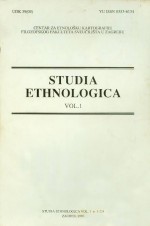Način života u istočnoj Hercegovini sredinom XIX stoljeća
The Way of Life in Eastern Herzegovina in the Middle of the 19th Century
Author(s): Damir ZorićContributor(s): Snježana Veselica (Translator)
Subject(s): Cultural history, Customs / Folklore, Geography, Regional studies, Ethnohistory, Cultural Anthropology / Ethnology, 19th Century
Published by: Sveučilište u Zagrebu, Filozofski fakultet
Keywords: way of life; Eastern Herzegovina; 19th century; Catholics; folk customs;
Summary/Abstract: The most important features of life in eastern Herzegovina have here been almost completely reconstructed on the basic of reports written by Italian missionaries who worked in eastern Herzegovina in the second half of the last century, complemented by other information (extracted from the accounts of French travel writers in Bosnia and Herzegovina, the travel records by A. J. Evans and an account written by the Italian consul in Sarajevo C. Durando, etc...). Although situated just one or two day-s ride from Dubrovnik, this part of the Mediterranean hinterland used to be completely untouched by civilization, relying on the old modes of extensive economy (i. e. agriculture and stock-breeding), abandoned to poverty worthy of compassion and Turkish despotism. Everyday life was permeated by superstition and naivety, but also a sort of authentic rationality. Housing conditions, which lacked any traces of comfort (people and animals lived in crumbling buildings infested with fleas) are reconstructed in the article. The author describes the mentality of the population, their habits and customs, clothes, relations with members of other religions, which used to be relatively good. The missionaries even stated that they spent a lot of time serving the Orthodox and Muslims who greatly respected Catholic missionaries because they trusted them as good doctors. The archival data on the Catholic population in this region enables us to observe their demographic movements. Another intention of the author is of a methodological nature, i.e. to show how archival materials are practically used in ethnological research.
Journal: Studia ethnologica Croatica
- Issue Year: 1989
- Issue No: 1
- Page Range: 99-120
- Page Count: 22
- Language: Croatian

